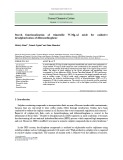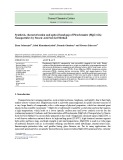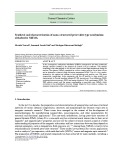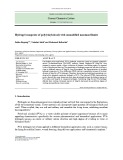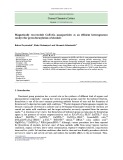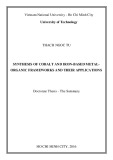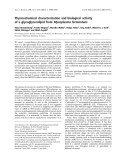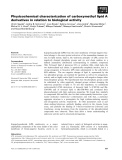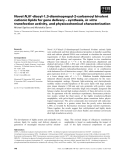
63
Journal of Medicine and Pharmacy, Volume 13, No.04, June-2023
Corresponding author: Ho Hoang Nhan, email: hhnhan@huemed-univ.edu.vn
Recieved: 22/2/2023; Accepted: 4/3/2023; Published: 10/6/2023
Optimization and physicochemical characterization of polymeric
nanoparticles containing tinidazole
Ho Hoang Nhan1*, Le Hoang Hao1, Ho Thi Thu Hue1, Phan Thi Thao Ngoc1
(1) Hue University of Medicine and Pharmacy, Hue University
Abstract
Background: Periodontitis is a chronic bacterial infection destroying tooth-supporting tissues. Like
metronidazole, tinidazole (TNZ) is also effective in treating periodontitis. The preparation of polymeric
nanoparticles containing TNZ helps to improve the solubility and increase the bioavailability of the drug.
Objectives: This study aimed to formulate and optimize TNZ nanoparticles and evaluate their physicochemical
properties. Materials and methods: TNZ, Eudragit RSPO polymer as a carrier were used in this study. TNZ-
loaded nanoparticles (TNZ NPs) were prepared by the solvent evaporation - emulsion method. The influence
of the factors in the formula and the preparation process of TNZ NPs was investigated and optimized
using MODDE 13.0 software. The physicochemical properties of NPs were evaluated by scanning electron
microscopy (SEM), X-ray diffraction (XRD), Fourier transform infrared spectroscopy (FT-IR), and in vitro drug
release. Result: The optimal TNZ NPs were spherical in shape, mostly amorphous, with particle size of 179.60
± 2.20 nm, polydispersity index of 0.149 ± 0.024, and encapsulation efficiency of 47.49 ± 0.02%. TNZ NPs
showed prolonged drug release in phosphate buffer pH 6.8 for up to 24 hours. Conclusions: The optimal TNZ
NPs would be a promising drug delivery system for periodontitis treatment.
Keywords: tinidazole, nanoparticle, periodontitis.
1. BACKGROUND
Periodontitis, a commonly observed dental
condition, is prevalent in Vietnam and other
countries worldwide. Epidemiological research
has revealed its widespread occurrence, affecting
approximately 20 - 50% of the global population.
This oral disease is prominent in both developed and
developing nations [1]. In Vietnam, dental diseases
affect over 90% of the population, with over 80%
experiencing permanent tooth decay and more than
60% of children and over 80% of adults suffering
from gum inflammation, periodontitis, and gingivitis.
Additionally, over 30% of adults have periodontal
pockets, causing tooth mobility. Periodontitis, a
chronic bacterial infection, destroys the supportive
tissues of the teeth. It is primarily caused by gram-
negative anaerobic bacteria beneath the gums and
is considered one of the two major threats to oral
health, leading to tooth loss [1].
Tinidazole (TNZ) is a nitroimidazole antibiotic
frequently used in clinical settings to treat
periodontitis. TNZ eliminates anaerobic bacteria
and protozoa by infiltrating their cells, subsequently
disrupting DNA strands or inhibiting DNA synthesis
[2]. TNZ possesses potent bactericidal properties
at low concentrations, offering broad-spectrum
coverage against a wide range of anaerobic bacteria.
It exerts rapid antimicrobial activity while exhibiting
minimal drug resistance during treatment [3].
Surgery is a common treatment for periodontitis,
but it is often supplemented with antibiotics.
Systemic antibiotic use for periodontitis is not
recommended due to uncertain drug concentrations
at the target site and potential side effects. On
the other hand, localized drug delivery systems
using nanoformulations allow for lower doses
but higher concentrations at the intended site,
reducing systemic toxicity and the need for frequent
administration. This approach improves treatment
adherence and patients' quality of life. Thus, nano-
based formulations containing TNZ have potential
for localized periodontitis treatment.
Hence, this study was aimed at optimizing
polymeric nanoparticles containing TNZ using the
solvent evaporation method and characterizing
their physicochemical properties.
2. MATERIALS AND METHODS
2.1. Materials
TNZ (purity of 100%, European Pharmacopoeia
10) was from China. Eudragit RSPO was purchased
from Evonik, Germany. Dichloromethane, Tween 80,
and hydrochloride acid (HCl) (analytical grade) were
from China. Poloxamer 407 was obtained from BASF,
Germany.








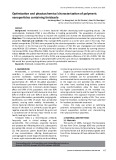
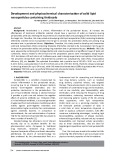
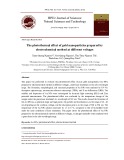
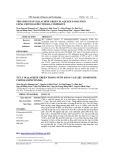
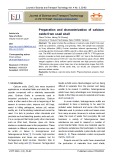
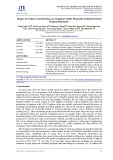
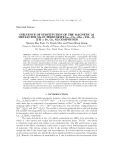
![Synthesis and anti-tuberculosis studies of 10-phenyl sulfonyl-2-alkyl/aryl- 4, 10 dihydrobenzo [4, 5] imidazo [1, 2-a] pyrimidin-4-one derivatives](https://cdn.tailieu.vn/images/document/thumbnail/2020/20200525/tocectocec/135x160/3621590394727.jpg)
